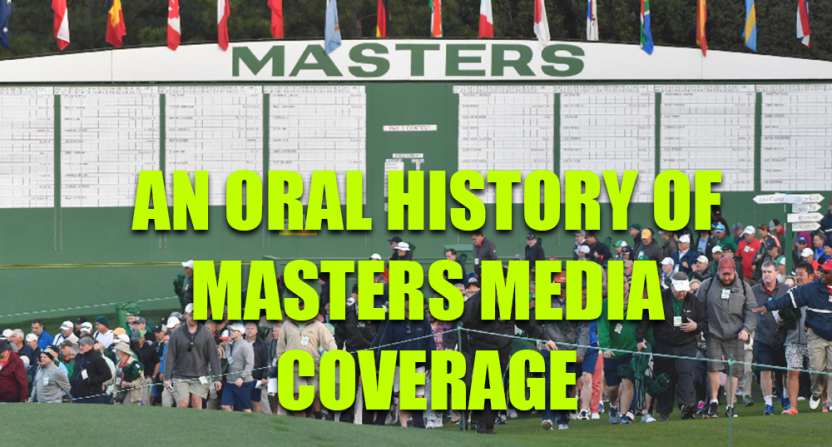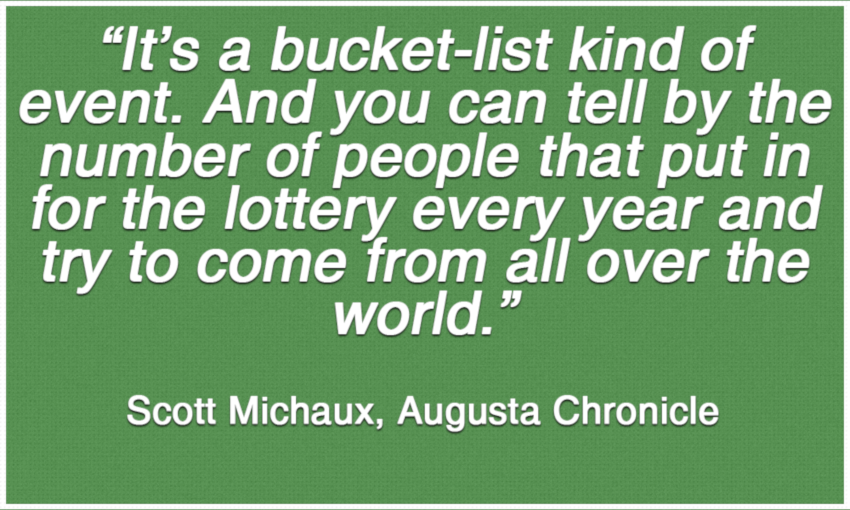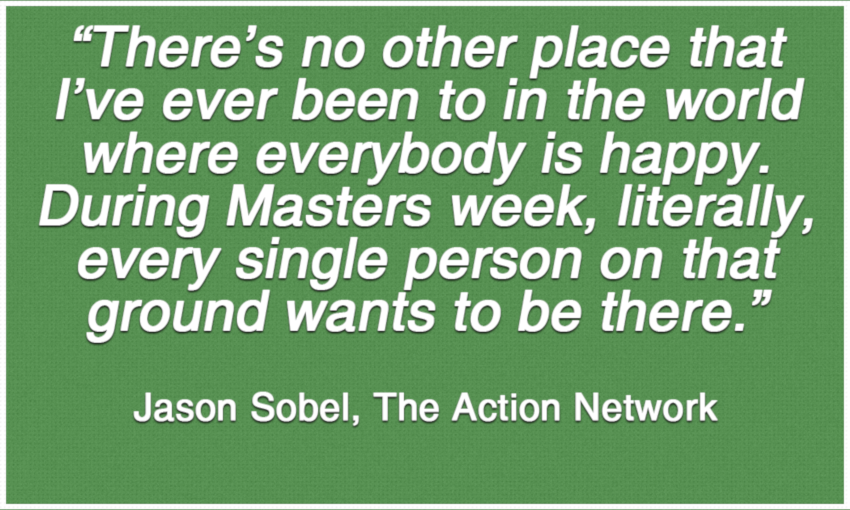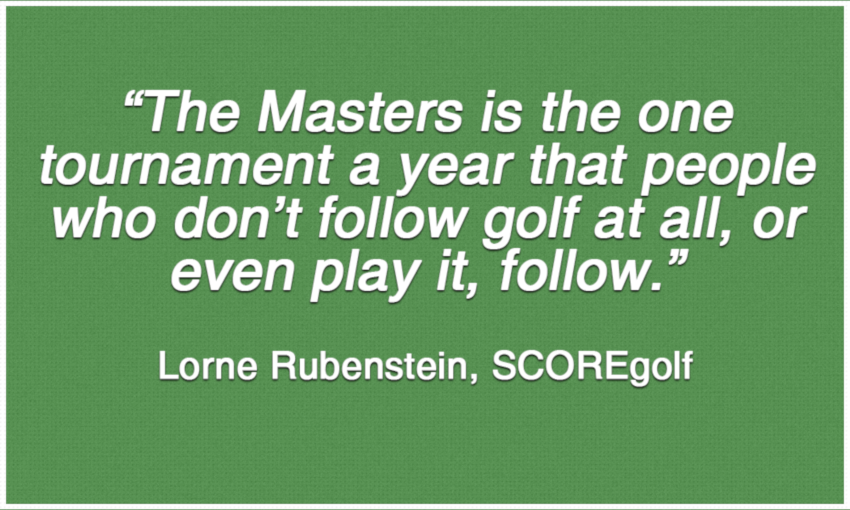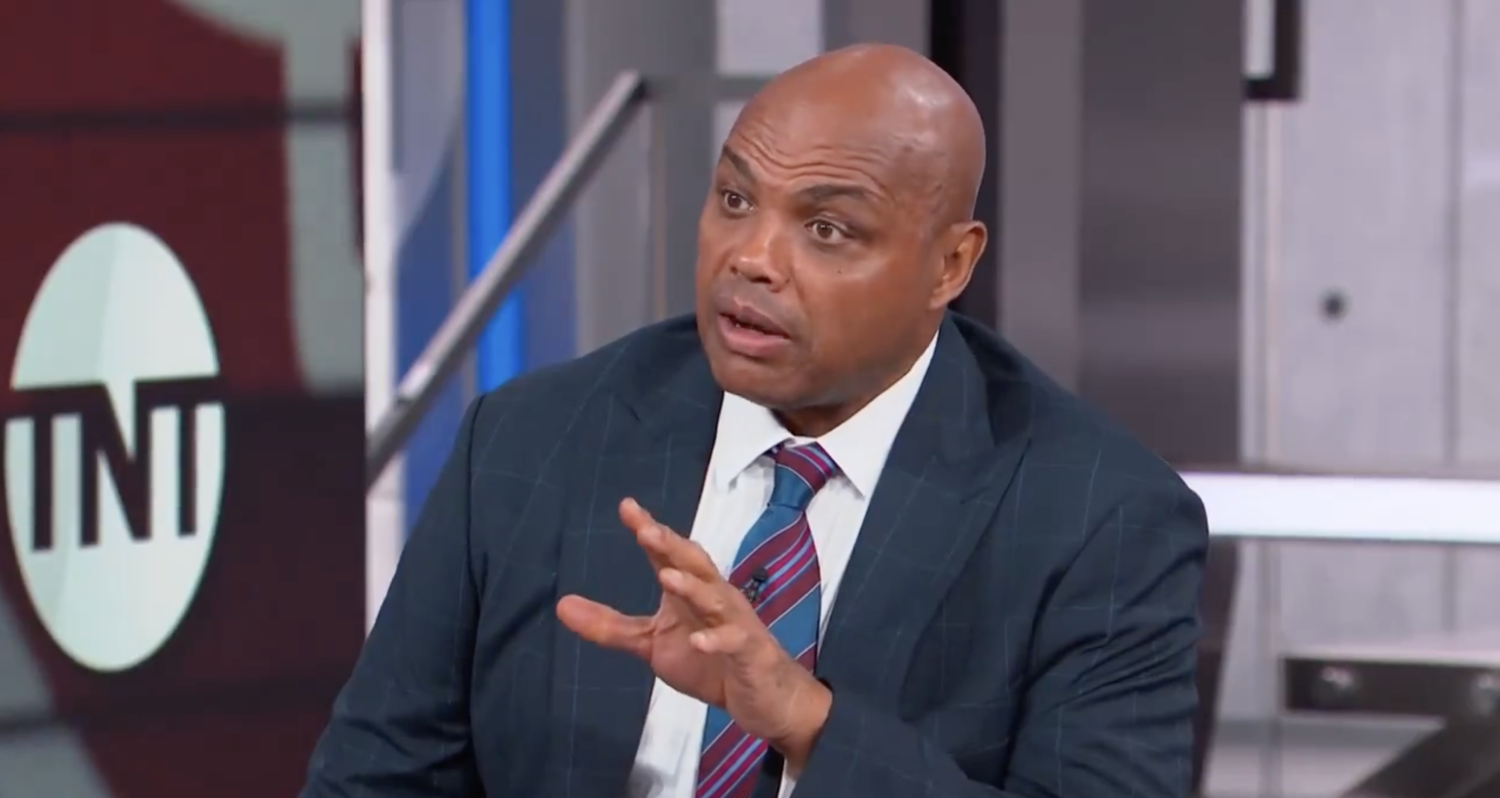Now in its 85th year, the Masters has hosted historic victories, upsets and prolific athletes on the green fields of Augusta National Golf Club. Take an inside look into the preparation, the moments and the pimento cheese sandwiches from leading sports media professionals.
Students from an Auburn University advanced sports reporting class connected with these pros to produce an oral history of Masters coverage. Here are the journalists and broadcasters who shared their insights with the students:
Steve DiMeglio, USA Today: In journalism for 30 years in a variety of roles, USA Today‘s golf writer for the last 12 years.
Doug Ferguson, Associated Press: Has worked for the AP since 1988, as full-time national golf writer since 1996. Recipient of the 2019 PGA Lifetime Achievement Award in Journalism.
Melanie Hauser, Golf Writers Association of America: Long-time journalist, prolific author (including of several golf books), secretary-treasurer of the Golf Writers Association of America.
Rick Henry, WIS-TV: At Columbia, SC’s WIS-TV since 1988, including as sports director since 1996. Named 1999 Sportscaster of the Year by the South Carolina Broadcasters Association.
Scott Michaux, Augusta Chronicle (1997-2018): Spent over two decades at the Augusta Chronicle, now a freelance writer.
Lorne Rubenstein, SCOREGolf: Founding editor of Canadian magazine SCOREGolf in 1980, golf columnist for The Globe and Mail for decades, past host of Acura World of Golf on TSN, author of books with Tiger Woods, Mike Weir and more, and recipient of the 2018 PGA Lifetime Achievement Award in Journalism.
Geoff Shackelford, Golfweek: Senior writer for Golfweek, weekly contributor to Golf Channel’s Morning Drive and Golf Central, co-host of The Ringer’s ShackHouse, author of eleven books.
Dave Shedloski, Golf Digest: Golf World & Golf Digest contributor, author, and magazine editor.
Jason Sobel, The Action Network: Senior golf writer for The Action Network, previously at ESPN and Golf Channel. Covering golf full-time since 2004.
PART ONE: First tournaments and the Masters’ popularity:
What makes the Masters unlike any other tradition?
Rick Henry: It’s the only one of golf’s major tournaments that’s played at the same course every year. The beauty of the course, the pimento cheese sandwiches, the demand for tickets all adds to the allure of the Masters.
Doug Ferguson: It has traditions that have grown. A green jacket for the winner. Excitement on the back nine. The Par 3 Tournament on Wednesday. Honorary starters (Jack Nicklaus and Gary Player). A Champions Dinner on Tuesday night. Mostly, though it’s the course and the fact it’s always the first full week in April. The golf schedule, early on, is built around the Masters.
Geoff Shackelford: They have so many “traditions” that are different from other events, many seen as old-fashioned, and yet it is the event in golf, and maybe all of sports, seen as the best one and most difficult ticket to get.
Scott Michaux: People all over the world have really become familiar with Augusta National, via television, and you know a lot of places are still in winter, or at least seems like winter, in April. So you know they get quite envious looking at the nice green and blooming azaleas, and it becomes a part of their annual lives to watch the Masters every April and start dreaming about spring and summer coming to them. But, it’s also just something that everyone in the world wants to go attend. It’s a bucket-list kind of event and you can tell by the number of people that put in for the lottery every year and try to come from all over the world. From every continent to show up just to go see a golf tournament. It’s just not that way for any other golf tournament.
Lorne Rubenstein: Augusta National has only improved year after year. It’s one of the tournaments that goes out of its way to provide everything. Everything is roomy there, and you just feel a sense of the importance of the history. I’ve always loved the history of the game so you have access to basically everywhere there. It’s something that everyone really looks forward to as soon as the season starts.
Melanie Hauser: It’s the one tournament that’s been played on that golf course for years. It was built on a nursery so it’s a gorgeous piece of property. It is the one event that everybody looks forward to getting that invitation. You step onto the grounds and it’s just a totally different feel than any place else you’ve ever been.. It is the one place that, if you’re not there in April, you feel like you’ve really missed something.
Jason Sobel: You know exactly what shots you’re going to see. You know all the holes of Augusta National. You understand what the telecast is like, the same music and commercial interruptions are just as familiar. I don’t think other sporting events have the same familiarity as the Masters.
Dave Shedloski: Even though a lot of things change there, it always feels like it never really changes. They always make it a very special event for the players and certainly one that they all want to win. It feels like time stands still there.
Steve DiMeglio: Just begin with the dazzling beauty. It’s a course where even non-golfers would say ‘oh, I’ve never hit a golf ball but I want to hit a golf ball on that golf course.’ The other thing that sets the Masters apart are the traditions. Number one to me would be the green jacket. I think it’s the most famous piece of clothing in golf history. The Par 3 tournament on Wednesday before the main tournament starts is as good of golf as you’ll ever see. You’ll see Jack Nicklaus’ grandson make a hole-in-one in front of Jack. You’ll see the little boys and girls–the daughters and sons of the players–going around in their white caddy suits. It’s just a great time.
What was the experience like covering your first Masters?
Michaux: I was working for the Greensboro News and Record at the time and I’d just taken over the golf beat in 1997. Newspapers were starting to see the first effects of struggling in the new economy. My sports editor was thinking it might be time for a change in the beat coverage. That it might be a good opportunity to stop covering the Masters tournament and get that expense off the books.
So I went into his office and told him that I thought it would be a huge mistake because Tiger Woods was going to win the Masters and this is going to be the biggest story in all the world. He would be the sports editor who decided not to cover it. He looked at me and said ‘Do you really think Tiger is going to win this tournament?’ I reached into my wallet. I had just been to Vegas for a friend’s wedding and I bet money on Tiger Woods at 20 to one odds. I went over there and I slapped down my betting slip on his desk and I said ‘Yeah I do.’
Rubenstein: I just remember how excited I was going to the Masters. When I was growing up you wouldn’t even get full coverage. They didn’t have nine holes. Maybe even when I first started, when I was a kid, we only got the last four or five holes. Most PGA Tour events you only got the last four or five holes. You’d tune in on a weekend and get 15, 16, 17 and 18. You really felt that ‘Wow, I’m going and I can provide my readers with something they can’t get.’ There was no social media, there wasn’t Twitter. The only way they could get information really was from watching it on television or radio reports or the next day’s newspaper.
Sobel: The first one I covered was in 2005. I walked all over the golf course and it was just different. I wrote about the first-timer’s perspective of Augusta National that day. It’s immaculate. You’ve never seen grass that pure. People are taking off their shoes and walking around without their shoes because it feels so good to your feet.
The one thing that always gets me about Augusta National, there’s no other place that I’ve ever been to in the world where everybody is happy. During Masters week, literally, every single person on that ground wants to be there. I can’t think of another place where every single person wants to be there. Maybe a family wedding. You got people there that are like “My girlfriend dragged me to this wedding, it wasn’t number one on my priority list.” If you go to the Masters, every single person there, that’s the number one thing on their list they want to do and want to be doing at that moment. I think that’s really cool.
Shedloski: It was the 1993 Masters, I was still working at a daily newspaper here in Ohio and we had decided we were going to cover the Masters and just see what it was like. It wasn’t necessarily something we were going to do every year, but we wanted to see what it was like. We were just assigned to report on what we saw and what we experienced. It was a pretty exciting time in my life. The place is just so beautiful, that’s the one thing you take away from it when you’re there for the first time. You’re just standing in awe saying, ‘Wow, it looks beautiful on TV but this is even better in person.”
Ferguson: I was in awe of the place when I arrived. Back then (1996), we parked in a gravel lot, went through the gates and it felt like being at Disneyland with the flags.
Hauser: I was very frustrated. I remember standing outside the clubhouse. It was rainy and gross, and I couldn’t go inside because there were no women allowed in that part of the clubhouse. They wouldn’t even open the door to let me see if my amateurs were having lunch in the men’s grill. I was pretty up in arms about it so, I kind of made friends with another female reporter there. We took it to the Golf Writers Association and said “Hey, this isn’t right.” And the next year, we were allowed in the locker room, the men’s grill, everywhere.
DiMeglio: I just couldn’t wait to park my car, get out, walk through those gates and go to my first Masters. I’ve never felt that way about any other golf tournament. I just had adrenaline flowing from the time I got the rental car in Atlanta until the time I returned the rental car in Atlanta. It’s like Dorothy going to Oz. I had no idea how much elevation change was there until I walked out to the 10th tee for the first time. It’s basically a ski run, going down Everest. Then you go to the 8th tee and see it go straight up to the Par 5. I had no idea. My eyes just popped.
What mistakes did you make?
Shackelford: I tried to watch too much of the golf on Sunday from the course. The Masters is a tough place to follow a group or really pick up much for coverage on course when a lot is happening on the back nine Sunday.
Ferguson: The only big mistake I recall was having to do our running copy for afternoon papers. Greg Norman shot 63 the first round, and back then, they paired based on scores after the first round. I didn’t update the story enough because no one who played early could get close to 9 under. Finally, the New York desk yelled (encouraged) to refresh the story. I had to come up with a creative way of doing that.
Shedloski: Did I make any mistakes? No. I don’t make mistakes. I’m too professional to make mistakes.
DiMeglio: There was only one time in my previous 12 years I was told ‘There’s no running here.’ I started jogging to go back to the clubhouse and one of the security officials in the yellow hat said “No. No. No. No running here.” So you’re always on your toes, but the biggest one is no cell phones. I walked out talking on my phone on a Sunday night when we were on deadline. I immediately said ‘what am I doing?’ and went right back in. If you use your cell phone on the golf course, they’ll know.
I’m a smoker but I guarantee you that’s the only place I’ve made sure every one of my cigarette butts ended up in a garbage can. I should apologize for that because I litter everywhere else, but there, you make sure you do not put cigarette butts out on the ground.
How does the Masters contribute to the overall popularity of the sport? How does it help reach those who don’t normally follow golf?
Rubenstein: The Masters is the one tournament a year that people who don’t follow golf at all, or even play it, follow. They know it’s coming up. They hear all of the talk about it. They read about it. They see what’s happening. It’s true now and it was true in Jack Nicklaus’ day at that ‘86 Masters. Because of its position on the calendar, the television ratings, the viewership and the social media engagement are higher than any other tournament around the world during the year. People see the drama in the tournament. It gets people out to the golf course and it would really propel you to want to go out and hit golf balls.
Ferguson: It is the single most popular event, so it works both ways. It reaches fans who don’t normally follow golf because there is a three-month buildup from the start of the year, the theme music is the same, the images are etched in minds of even non-golf fans because they remember the holes and the course. And it’s the first major of the year, which adds to it. The ratings are always the highest and sometimes there will be a carryover to the next major. But other majors, and the PGA Tour, still feel like they all play second-fiddle to Augusta National, which they do.
DiMeglio: I think they’re drawn in by the beauty. I think they’re drawn in by the history. For people who don’t follow golf, it’s their first golf experience of the year. It comes at a time when half of the country is thawing out. You’re coming out of the hibernation of winter. You’re coming into spring. Anything that can draw people who otherwise don’t care about golf for 51 weeks out of the year, is a good thing. Because now, some of those people might convert and maybe they’ll start watching a little more golf. I think that’s Augusta National’s reach. When a tournament is able to do that, that’s saying something.
Henry: People will watch it just to see the dogwoods and azaleas in bloom.
Shackelford: An exciting Masters makes people more excited about golf because the telecast is not too long, and because it’s so familiar to even casual fans. Watching seems to be a tradition for non-sports fans, even.
Sobel: I think it’s huge. I think that there are people who don’t start watching golf every year until the Masters. The people who aren’t die-hard golf fans, like me, and people who aren’t paying attention on a week in and week out basis. I try to look at it as I do as a casual tennis fan, as opposed to golf, because I’m very entrenched in golf. I couldn’t tell you what tennis tournament is going on this week because I don’t really pay that much attention. I couldn’t name but only five or six players that are playing right now. Yet, if you have Wimbledon on TV, and Federer and Djokovic are playing each other, then I’m going to turn it on and think, “man this is great, I can’t wait to watch this.”
I think people feel the same way about the Masters. When you’ve got the bigger names like the Tigers and the Phils, and guys like that who are up there on the leaderboards playing each other at the Masters, I think that transcends being a golf fan. It transcends knowing a lot of the players. If you understand what the Masters was and you understand what golf is, you say, “that’s the one I’ve got watch.” Even if I don’t like golf that much, even if I’m just a casual fan, I know that every April on that Sunday, I will be parked in front of the couch because everyone else is going to be talking about it.
Shedloski: I think it helps the popularity of the sport because even the average golfer knows Augusta National, and I think everyone can appreciate what the Masters is. In some ways, the Masters is part of the average golf follower’s tradition.
Michaux: I really think it sort of defines what golf is and what major championship golf is to a lot of golf fans. And even to the players, I mean, it’s the one event that they all want to be a part of. It’s the most exclusive of the majors to get into, so it’s the hardest one for them to qualify to play for. And most of the guys, if you ask whether there’s one tournament that they want to win, one major championship, it’s the one they want to win most of all. That’s the one where they get to go back every year for the champions dinner, wear that green jacket every year, and you really become a part of the history rather than just a name on the trophy. That’s when the excitement really really starts building for the golf season more than anything else.
PART ONE: First tournaments and the Masters’ popularity.
PART TWO: What is it like to cover the Masters in person?
PART THREE: Favorite players to cover and memorable great moments.
PART FOUR: Collapses and controversies.
PART FIVE: Tiger Woods’ impact on the Masters

